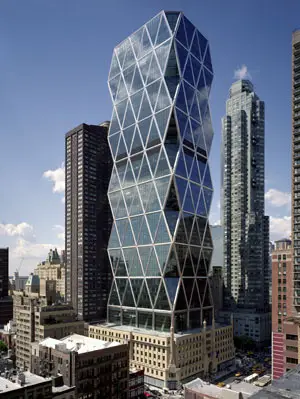 Hearst Tower is the world headquarter of the Hearst corporation which shelters many of their publications and communications companies like Cosmopolitan, Good Housekeeping, San Francisco Chronicle and others under one roof.
Hearst Tower is the world headquarter of the Hearst corporation which shelters many of their publications and communications companies like Cosmopolitan, Good Housekeeping, San Francisco Chronicle and others under one roof.
Earlier there used to be a six-story headquarter building which was commissioned by William Randolph Hearst (the founder) and was built by architect Joseph Urban. That building was completed in 1928 with a total cost of $2 million.
In the new design, the earlier cast stone facade has been preserved as a designated Landmark site. The new tower addition took place after around 80 years. On 4 May 2006, around 2000 Hearst employees moved to this new tower.
This tower was designed by architect – Norman Foster and constructed by Turner Construction. It is 46 stories tall and is 182 meters in height. The triangular framing pattern required 9,500 metric tons of structural steel. Hearst tower was the first skyscraper to break ground in New Yourk city after 11 September, 2001. In 2006, this building was awarded with Emporis Skyscraper Award, citing it as the best skyscraper in the world completed that year.
Hearst Tower is the first green building in New York, as it was built with a number of environmental considerations. The floor of the atrium is covered with heat conductive limestone. The floor has a tubing network of polyethylene underneath which is filled with circulating water which cools the building in summer and heats it up in winter. The rain water is collected in a tank situated in basement which is used for cooling system, to water plants and fulfills the need of water sculpture of the main lobby.
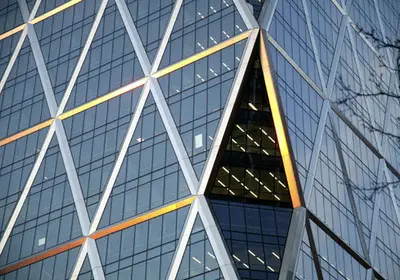 The main source of steel for this building (around 80%) is from scraps (i.e recycled). This building uses around 25% less energy than general energy requirement in New York City.
The main source of steel for this building (around 80%) is from scraps (i.e recycled). This building uses around 25% less energy than general energy requirement in New York City.
The escalators in the atrium run through a 3 storey water sculpture named Ice fall (this waterfall is built with thousand of glass panels which helps in cooling and humidifying the lobby air). Also, a fresco painting (River lines) complements the water element in the atrium.
Some more pics…
Hearst Tower in “Night-Lights”
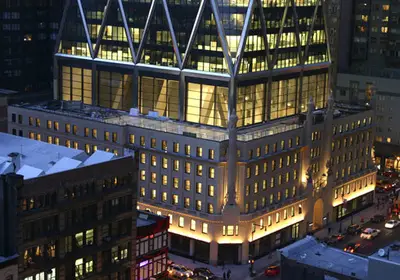
Hearst Tower during construction
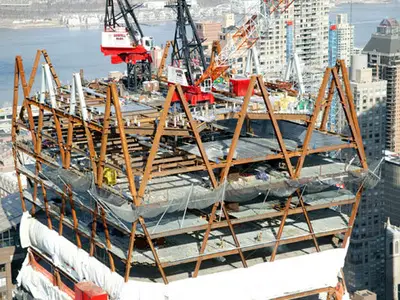
View of Cafe 57 and Atrium
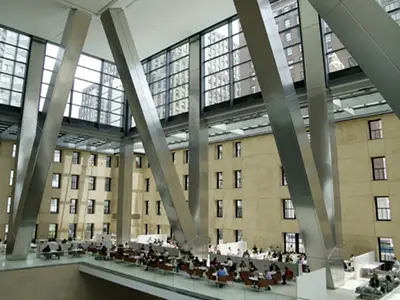
Interior workspace in Hearst Tower
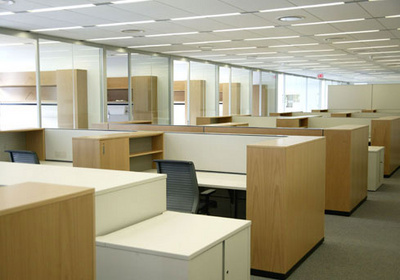
Artist Richard Long nears completion of Riverlines (fesco)
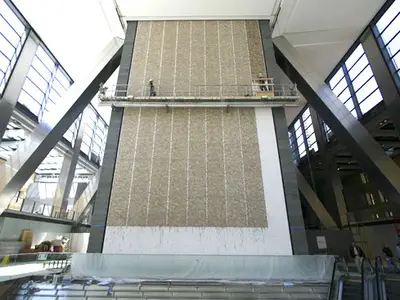
Finally, Hearst Tower makes it up to New York’s Skyline
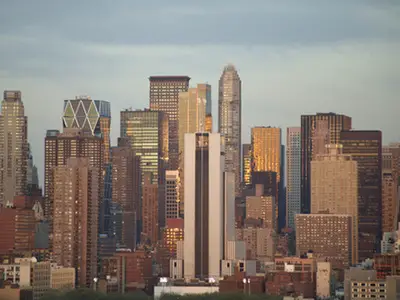
Do you know why Hearst Tower is famous?
The triangular fascade of the building is not just any glass framing pattern. They are actually the steel columns, the load bearing framed structure of the building. And the intresting thing about them is – not even one of the columns is straight (look at the pics more carefully, you will realize the beauty of the building).
The building is designed in such a fashion that not even a single column is vertical, they are all slanting, inwards and outwards alternately. Further, each triangular section accomodates 4 floors. So the columns change their leaning direction after every 4th floor. The const team didnt knew how to hold these slanting columns in their positions for sometime, till which the floors could be welded to them. Somehow, the task was accomplished. The individual floors are tied to these columns at their edges, leaving no load bearing walls or columns in their spans. Hence the layout of the offices and their interiors can be changed at will without any obstruction whatsoever.
Also, the glass and steel fascade reduces the heat absorbance of the building as chemically coated glass prevents suns heat from entering the building, which a concrete or aluminium clad structure usually absorbs. This alone cuts the air conditioning costs of the building and reduces the overall elec consumption by 25%. Earlier, the structure was a six storeyed building. Its foundations were not strong enough to bear the weight of the multistorey tower. So the architect demolished the floors on the existing structure, leaving only the limestone clad fascade, to send the columns of the abovelying tower down below the earth. The ground floor had the enterance while the first floor had only a little area along the fascade for staff seating and circulation. Rest of the volume composed a six storey high reception atrium from the ground floor to the sixth floor. Also the triangular slanting sideways and leaning in-out column structure imparted unique strength and stability to the building against earthquakes, cyclones and hurricanes which hit New York frequently.
This triangular character is very similar to The Hall Of Nations by Raj Rewal, built only 25 years before this structure.

I am interested in touring
I am interested in touring this building and learning more about it. Is a tour available?
Also is there a restaurant for tourists?
Hi
I need some video that
Hi
I need some video that show
hearst towne structure .
A spell check would be really
A spell check would be really helpful on this interesting article. Those mistakes took away from the reliability of the article.